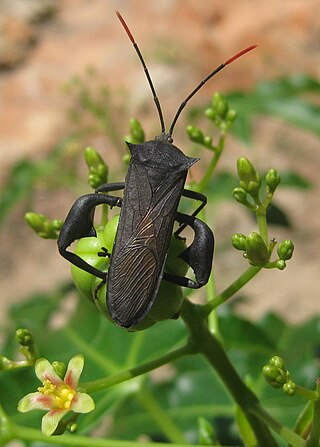
Coreidae is a large family of predominantly sap-sucking insects in the Hemipteran suborder Heteroptera. The name "Coreidae" derives from the genus Coreus, which derives from the Ancient Greek κόρις (kóris) meaning bedbug.
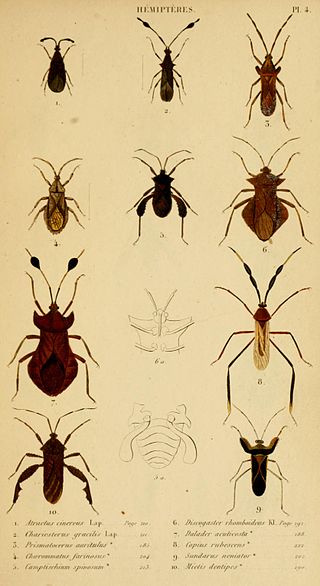
Charles Jean-Baptiste Amyot was a French lawyer and entomologist especially interested in the Hemiptera.

The Lygaeoidea are a sizeable superfamily of true bugs, containing seed bugs and allies, in the order Hemiptera. There are about 16 families and more than 4,600 described species in Lygaeoidea, found worldwide. Most feed on seeds or sap, but a few are predators.

The Rhyparochromidae are a large family of true bugs, many of which are commonly referred to as seed bugs. The family includes two subfamilies, more than 420 genera, and over 2,100 described species.

Coreinae is a subfamily in the hemipteran family Coreidae. They have been shown to be paraphyletic with respect to Meropachyinae.

The Harpactorinae are a large subfamily of the Reduviidae. About 300 genera and 2,000 species worldwide have been described. Some of the species of the genera Zelus, Pselliopus, Sinea, and Apiomerus are of interest as biological pest control agents.
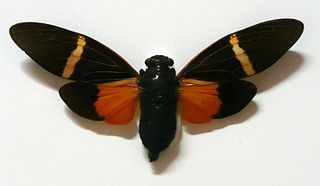
Tosena is a genus of cicadas from South-East Asia. They are the type genus of tribe Tosenini. Species formerly included in Tosena are Distantalna splendida, Formotosena montivaga, Formotosena seebohmi and Trengganua sibylla.

The Thyreocoridae are a family of shield bugs, known by common names that include negro bugs or ebony bugs. Historically, a few authors have called this family "Corimelaenidae" (e.g.), but the name Thyreocoridae, published in 1843, has nomenclatural priority over Corimelaenidae, published in 1872. Other classifications have placed them as a subfamily within the broad family Cydnidae.

Zicrona is a genus of bugs of the family Pentatomidae. It was circumscribed by Charles Jean-Baptiste Amyot and Jean Guillaume Audinet-Serville

Rhopalinae is a subfamily of scentless plant bugs in the family Rhopalidae. There are more than 170 described species in Rhopalinae.

Dalader is the type genus of coreid bugs in the Daladerini tribe. Species in the genus are distributed in tropical Asia, chiefly Southeast Asia. The genus name is derived from the Sanskrit roots dal meaning leaf and dhru which means bearer. This plant bug genus is distinguished by the which preterminal antennal segment being flattened, pear-shaped, and ridged and the terminal segment being paler. Chalcidoid egg parasites have been recorded from this species. Adults of Dalader acuticosta are fried and eaten in northeastern India.
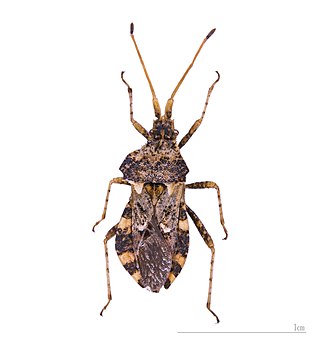
Coreini is a tribe of leaf-footed bugs in the family Coreidae. There are at least 20 genera and 70 described species in Coreini.

Smiliinae is a subfamily of treehoppers in the family Membracidae. These are bugs and include about 100 genera in 10 tribes.

Namacus is a genus of leaf-footed bugs in the family Coreidae. There are at least four described species in Namacus.

Pachygronthidae is a family of true bugs in the order Hemiptera. There are about 14 genera and more than 80 described species in Pachygronthidae.
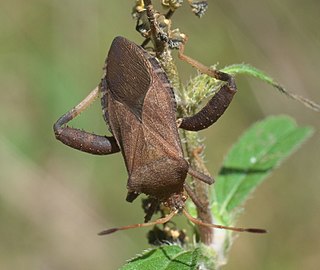
Acanthocerini is a tribe of leaf-footed bugs in the family Coreidae. There are at least 20 genera and 50 described species in Acanthocerini.

Pochazia is a genus of true bugs belonging to the family Ricaniidae.

The Acanthocorini are a tribe of leaf-footed bugs, in the subfamily Coreinae erected by Amyot and Serville in 1843. Genera are distributed from Africa, South-East Asia through to Australia.

The Homoeocerini are a tribe of leaf-footed bugs, in the subfamily Coreinae erected by Amyot and Serville in 1843. Genera are distributed from Africa to South-East Asia.

Smilia is a genus of treehoppers belonging to the tribe Smiliini in the subfamily Smiliinae. There are at least two described species in the genus.


















